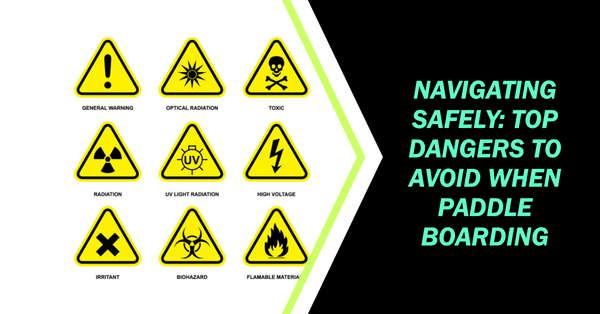
Navigating Safely: Top Dangers to Avoid When Paddle Boarding, Including Toxic Algae Blooms.
Paddleboarding has swiftly gained popularity as a serene yet exhilarating water activity that allows enthusiasts to commune with nature while getting a great workout. With its roots tracing back to ancient cultures and surfboarding, paddleboarding has evolved into a standalone sport, attracting a diverse group of participants seeking adventure and relaxation. While the serene waters might seem inviting, it's essential to be aware of potential dangers lurking beneath the surface. In this article, we'll delve into the top dangers to avoid when paddleboarding, with a special focus on the often overlooked threat of toxic algae blooms.
1. Lack of Proper Safety Gear:
One of the most crucial elements of a safe paddleboarding experience is the use of appropriate safety gear. A personal flotation device (PFD) is a non-negotiable item that can make the difference between a minor inconvenience and a life-threatening situation. Even for experienced swimmers, a PFD provides an added layer of security, especially when paddling in unfamiliar or potentially turbulent waters. A first aid kit is another item you should have with you or your group.
2. Ignoring Weather Conditions:

Weather conditions have a significant impact on the safety of your paddleboarding expedition. Calm waters can swiftly transform into choppy waves in the presence of strong winds, and sudden storms can catch even the most experienced paddlers off guard. Always check weather forecasts and sea conditions before heading out, and be prepared to change your plans if conditions deteriorate unexpectedly.
3. Inadequate Skill and Knowledge:

Paddleboarding might appear straightforward, but improper technique and lack of knowledge can lead to accidents and injuries. Before venturing out, invest time in learning the basics of balance, paddling strokes, and turning maneuvers. Enrolling in a beginner's class or seeking guidance from experienced paddleboarders can greatly enhance your skills and boost your confidence on the water.
4. Neglecting Sun Protection:
Paddleboarding often takes place under the open sun, exposing you to potentially harmful UV rays. Neglecting sun protection can lead to sunburns, skin damage, and even heat-related illnesses. Apply sunscreen with a high SPF that is reef safe, wear protective clothing like rash guards, and don't forget to don a wide-brimmed hat and sunglasses to shield yourself from the sun's harsh glare.
5. Unpredictable Water Conditions:
Even on seemingly calm days, water conditions can change unexpectedly. Strong currents, tides, and underwater obstacles can pose serious threats to paddleboarders. To mitigate these dangers, familiarize yourself with the local water conditions, consult tide charts, and pay attention to signs indicating hazardous areas.
6. Lack of Situational Awareness:

Distractions, such as taking pictures or chatting with fellow paddleboarders, can lead to a lack of situational awareness. This oversight can result in collisions with boats, kayaks, or other paddleboarders, leading to injuries for all parties involved. Always stay vigilant and be aware of your surroundings, especially in areas with heavy watercraft traffic.
7. Toxic Algae Blooms:
One often underestimated danger when paddleboarding is toxic algae blooms. These are rapid overgrowths of algae in water bodies, spurred by factors such as warm temperatures, nutrient pollution, and stagnant water. Some algae species produce harmful toxins that can contaminate the water, posing risks to aquatic life, humans, and pets. Paddleboarders can accidentally come into contact with these toxins through splashes or direct skin contact, leading to skin irritation, respiratory issues, and more severe health problems.
To protect yourself from toxic algae blooms, follow these precautions:
-
Stay Informed: Check local environmental agencies or health departments for any alerts about harmful algae blooms in your chosen paddleboarding location.
-
Avoid Discolored Water: If the water appears discolored, murky, or has a foul odor, it's best to avoid paddleboarding in that area.
-
Minimize Skin Contact: Wear appropriate clothing that covers your skin and reduces direct contact with the water. Additionally, consider using gloves and water shoes.
-
Rinse Thoroughly: After paddleboarding in potentially affected waters, make sure to rinse yourself and your equipment thoroughly to remove any residue that might have come into contact with the toxins.
Glide's guide to finding places to view wildlife and where to paddle board.
For wildlife tips check out our blog and this article on Beginners Guide To Bird Watching. And don't forget to read our article on Stand Up Paddle Boarding and Wildlife Encounters. For a complete guide on where to paddle board in every state, this one is for you! The best places to paddle board in the United States a state by state tour of where to paddle board with Glide Paddle Boards. Or perhaps something international is what you are looking for, then these two articles will help out. Check out the ultimate guide on finding places to paddle board near you for tips and tricks on finding new and exciting places near you! And for international spots Epic Spots Globally To Paddle Board is for you!
For sup yoga, this is the article for you, The Best Spots for SUP Yoga in Idaho: Connecting Mind, Body, and Nature. If you are new to sup yoga check out our sup yoga poses for complete beginners.

